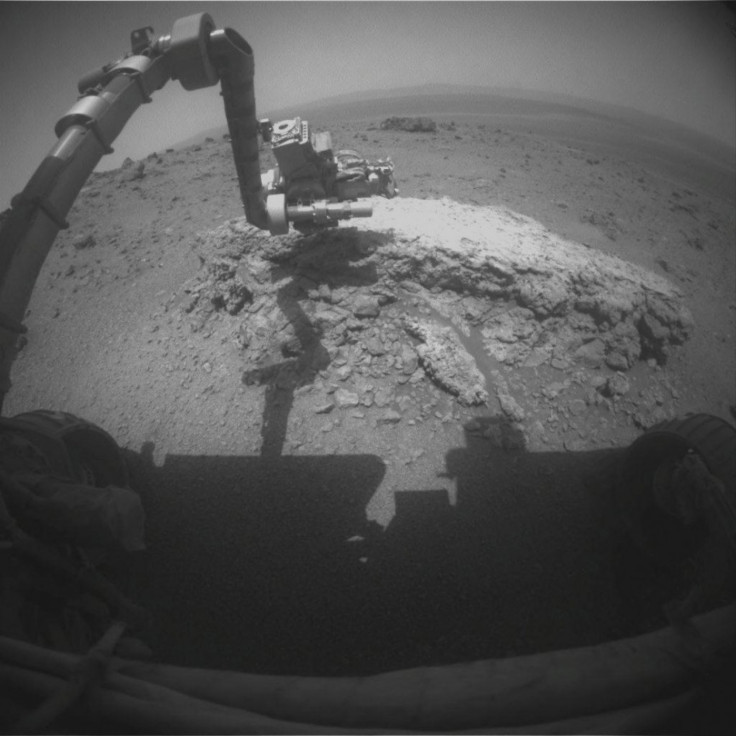Opportunity Rover Finds Rock Never Seen Before on Mars

NASA's Mars Exploration Robotic Rover Opportunity has reached the Red Planet's Endeavour crater, and the first rock it examined itself is creating waves among astronomers.
Opportunity's findings and data from the upcoming Mars Science Laboratory are expected to play a key role in advancing possible future human missions to Mars and other planets.
Scientists say the first rock examined by Opportunity is similar to volcanic rocks, but contains more zinc and bromine. The findings assume significance as on Earth zinc is commonly found in rocks that have been exposed to hot water and support earlier findings that life may have once existed on Mars.
Earlier observations by Mars orbiters have suggested that rock exposures on Endeavour's rim and clay minerals that form in less-acidic wet conditions are possibly more favorable for life.
Opportunity arrived at the western rim of 13-mile-diameter Endeavour crater three weeks ago. The first rock it examined, informally named Tisdale 2, is flat-topped and about the size of a footstool and was apparently excavated by an impact that dug a crater the size of a tennis court into the crater's rim.
This is different from any rock ever seen on Mars, said Steve Squyres, principal investigator for Opportunity at Cornell University in Ithaca, N.Y. It has a composition similar to some volcanic rocks, but there's much more zinc and bromine than we've typically seen. We are getting confirmation that reaching Endeavour really has given us the equivalent of a second landing site for Opportunity.
The diversity of fragments in Tisdale 2 could be a prelude to other minerals Opportunity might find at Endeavour. In the past two weeks, researchers have used an instrument on the rover's robotic arm to identify elements at several spots on Tisdale 2.
Discontinuous ridges are all that remains of the ancient crater's rim. The ridge at the section of the rim where Opportunity arrived is named Cape York. A gap between Cape York and the next rim fragment to the south is called Botany Bay.
Opportunity and its rover twin, Spirit, completed three-month prime missions in April 2004 and continued working for years of extended missions. Both have made important discoveries about wet environments on ancient Mars that may have been favorable for supporting microbial life. Spirit ended communications in March 2010, but Opportunity continues to send data.
We have a very senior rover in good health for having already worked 30 times longer than planned, said John Callas, project manager for Opportunity at NASA's Jet Propulsion Laboratory in Pasadena, Calif.
But Callas warned, At any time, we could lose a critical component on an essential rover system, and the mission would be over. Or, we might still be using this rover's capabilities beneficially for years. There are miles of exciting geology to explore at Endeavour crater.
With in-situ work finishing at Tinsdale 2, Opportunity will next be directed to drive away and head to the northeast where the iron magnesium steatite clays are seen from orbit.
Opportunity is a six-wheeled, solar-powered robot measuring about 4.9 feet high, 7.5 feet wide and weighing 400 pounds. The robot's solar arrays generate about 140 watts for up to four hours per Martian day (sol) while rechargeable lithium ion batteries store energy for use at night.
Communications from the robot depend on two antennas -- high-gain and low-gain -- both in direct contact with Earth. A low gain antenna is also used to relay data to spacecraft orbiting Mars.
Opportunity's total odometry, which indicates how far a robot is traveled, is 20.83 miles (33,525.68 meters, or 33.53 kilometers).
Meanwhile, NASA is expected to launch its next-generation Mars rover, Curiosity, between Nov. 25 and Dec. 18. The $2.5 billion rover, which would land on Mars in August 2012, is considered as one of the most advanced rovers yet.
JPL manages the Mars Exploration Rover Project for NASA's Science Mission Directorate in Washington.
© Copyright IBTimes 2024. All rights reserved.











